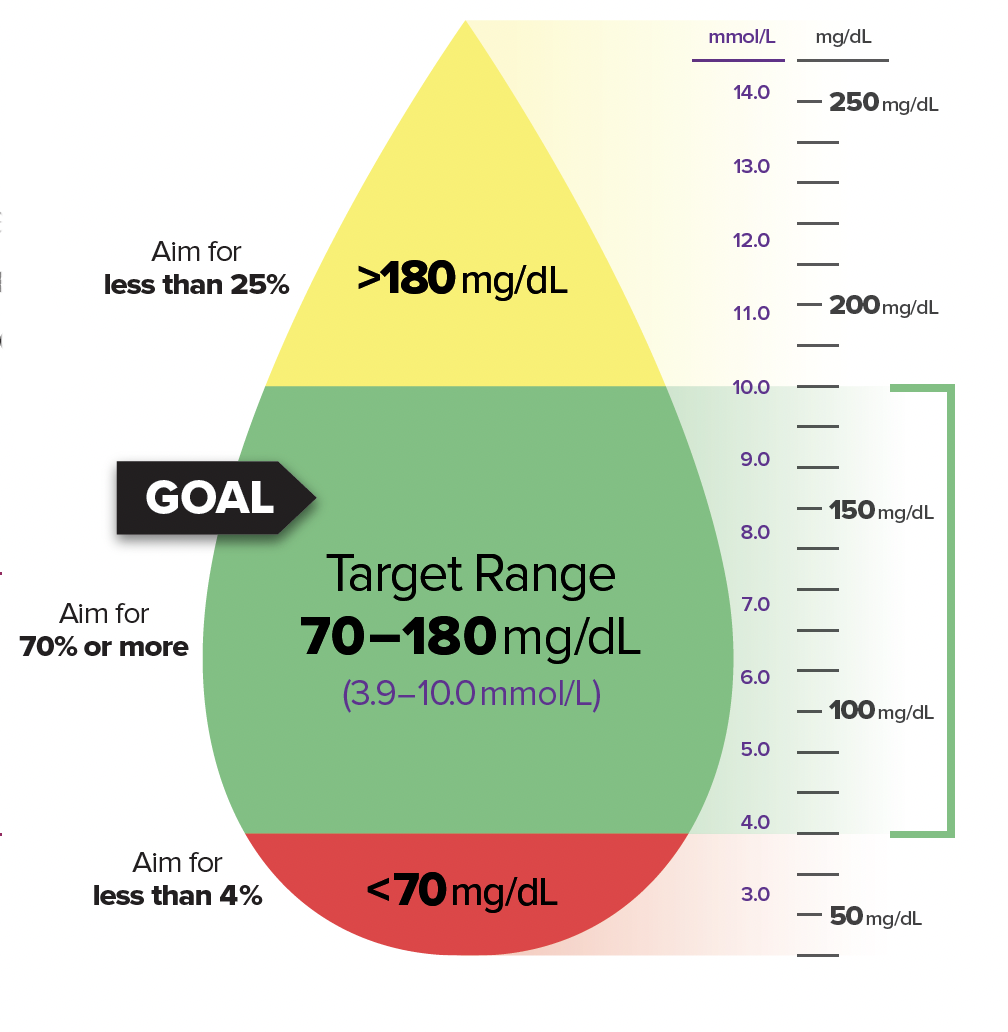Let me tell you a story about an imaginary friend named Gluco who lives inside my son’s body. Gluco is… well, let’s just say he has a flair for the dramatic.
One minute he’s chilling on the couch—blood sugar levels in the happy zone. The next, he’s sprinting up the walls like he just had a triple espresso chased with maple syrup. Other times, he’s curled up in a low-blood-sugar puddle like a cat who fell asleep inside a refrigerator. (Okay, no more goofy representations… probably.)
This is what managing diabetes feels like some days—like trying to herd cats that have both ADHD and strong opinions about snack time. But over the years, one thing has helped us make sense of the chaos: Time in Range.

Wait, What’s Time in Range?
Time in Range (TIR) is basically a scorecard for how often your blood sugar stays within a target zone. For most people with diabetes, the magic zone is between 70 and 180 mg/dL.
Think of it like a kid’s birthday party: you want things to stay fun and manageable. If it gets too high (chaos, cake overload, questionable piñata swings), or too low (someone’s crying and it’s not even the birthday kid), things get unpredictable fast.
(Okay—one more goofy representation. Promise.)
For a long time, diabetes management focused on average blood sugar. That’s where the A1C comes in—a three-month average. And averages can be deceiving.
You could have an average blood sugar of 150 mg/dL—but does that mean it’s good?
As a kid, my parents used to praise me for my average grades on my report cards. But what they didn’t see was that I goofed around in class, failed three out of five spelling tests, and then brought it home with two perfect scores. A well-deserved C.
For your “average” of 150 mg/dL, you could be spending half the day over 300 and the other half sipping juice boxes in a hypoglycemic fog. Averages lie.
But TIR? TIR tells you how often your blood sugar is actually hanging out in the sweet spot—being cool, calm, and collected.
How Do You Know Your Time in Range?
Cue the glucose sensor—one of the greatest parenting tools since baby wipes and screen time. (And yes, they’re great for adults with diabetes too.)
Continuous Glucose Monitoring (CGM) tracks blood sugar every few minutes and gives you real-time feedback. It’s like having a weather app for your kid’s pancreas.
Instead of only checking when you prick a finger (which, let’s be honest, is about as fun as stepping on a LEGO), CGMs show patterns over days and weeks. And from that data, we get the magic percentage: how often blood sugar stayed in range.
So if your kid’s CGM says 65% TIR, that means their glucose was between 70–180 mg/dL for 65% of the day. Not perfect, but not bad. If Gluco the imaginary sugar sprite stayed calm for nearly two-thirds of the day, we consider that a minor miracle. Pop the juice box—we’re celebrating.
Why Time in Range Actually Matters
Because it turns out, how often blood sugar is in range makes a big difference. Studies show that higher TIR is linked to fewer complications—less eye damage, fewer kidney problems, and better heart health.
That’s the science part.
The real-life part?

It means fewer scary lows. Less cranky, sluggish highs. Fewer emergency backpack candy raids. More “let’s go to soccer practice” and less “hold on while I treat a low and cry softly into this fruit snack.”
It also gives you a goal that’s not “perfect blood sugar all the time”—which, spoiler alert, is not a thing. Nobody, not even the most elite diabetes ninja warrior, hits 100% TIR. That’s like expecting your kid to eat kale chips and love them.
Aim for progress, not perfection.
Most clinicians suggest aiming for 70% or more TIR, which equals about 17 hours out of 24. And if you’re not there yet? That’s fine. Even bumping it up 5% makes a difference.
Five percent is just over an hour a day. You can do a lot in an hour: walk the dog, misplace your phone, realize you’ve been holding your coffee mug for an hour but forgot to drink it.
What Gets in the Way?
Everything.
I mean, have you met diabetes?
Hormones, growth spurts, forgotten snacks, overestimated snacks, stress, exercise, surprise illnesses, sleepovers, math tests, humidity, your neighbor’s weird WiFi signal—okay, maybe not that last one, but it sure feels like it sometimes.
Oh, and did I mention trampolines?
Blood sugar doesn’t follow rules. Sometimes, despite your best efforts, it rebels like a toddler in Target. But knowing what your TIR is helps you understand what’s happening over time.
It’s not about judgment—it’s a flashlight, not a scorecard.
A Few Things That Help
In our house, we approach TIR with a mix of data, detective work, and snack negotiations.
- Trends over time: We don’t obsess over one bad day. If TIR was 80% all week and 42% on the day with a birthday party, a water balloon fight, and a hot dog that may or may not have been fully cooked—we cut ourselves some slack.
- Use CGM alerts wisely: We try not to set alerts that go off so often they feel like fire drills. No one needs panic-mode at 2 a.m. because blood sugar is at 181.
- Talk about it like a weather report:
“Looks like some highs this morning after breakfast. Let’s see what we can do differently tomorrow,” works better than “What happened with your numbers??”
(Although let’s be real—sometimes the second one slips out.) - Celebrate improvement: When our son’s TIR ticked up from 52% to 60%, we high-fived like we’d won the Stanley Cup. We’re not above bribing with tacos either.
The Emotional Side
Here’s the thing: for kids (and their parents), diabetes already asks a lot. Monitoring TIR can help, but it can also feel like just another number to worry about.
That’s why we try to keep it in perspective. It’s a tool—not a judgment.
I remind my son often: You are not your numbers. You are not your percentage.
You’re a kid who happens to wear a glucose sensor and still manages to do cannonballs, climb trees, and negotiate for extra dessert with unnerving skill.
And to be honest, some days I have to remind myself, too.
Final Thoughts
Time in Range is a helpful way to measure how well blood sugar is staying within target—but it’s not the only thing that matters. It’s part of the puzzle—a useful compass on the diabetes road trip, but not the whole GPS.
And remember: there will be days when the range feels more like a rollercoaster. Nights where you treat three lows and one high before you’ve even finished your cup of decaf.
There will be weeks when Gluco, our unpredictable inner sugar sprite, forgets his chill entirely.
But there will also be wins. A tighter range. A better trend. A day where nothing beeps.
And through it all, you’ll still be there—navigating, nudging, laughing, and loving your kid through every up and down.
And that? That’s what’s really in range.
The infographic of Time in Range was found on Nutrition Habits If you’re in search of nutritional help with your diabetes management, you should check them out

